![]() Richter DC, Ott F, Auch AF, Schmid R, & Huson DH (2008). MetaSim: a sequencing simulator for genomics and metagenomics. PloS one, 3 (10) PMID: 18841204
Richter DC, Ott F, Auch AF, Schmid R, & Huson DH (2008). MetaSim: a sequencing simulator for genomics and metagenomics. PloS one, 3 (10) PMID: 18841204
An article from the Huson's Group at Tübingen University has just came out in the Open Access (and scientific publishing innovator) journal PLoS ONE, describing MetaSim, a software to produce artificial or syntetic or in silico metagenomes out of a selection of completely sequenced genomes.
This is just "heaven-sent" for me since I've been working on a set of syntetic metagenomes for the past two months, and will be happy to use this software first hand like... today. It seems that the software not only lets you choose the source genomes from a phylogenetic tree (figures reproduced here from the original article al PLoS ONE thanks to the Creative Commons License), but also choose from three different type of sequencing technology output (Sanger, 454 and Illumina) and generate theorethical metagenome. 
This is the continuation of a very important change in genomic sciences, moving from experiments far too expensive or long to be replicated and hence out of hard statistical comparision, to null-model based in silico genomic analysis.
The first effort to analyze the true scope of metagenomic analysis was presented by Kostas Mavrommatis and others from the Genome Biology group at JGI (unfortunately published in an non-OA journal), where they produced three simulated metagenomes of contrasting complexity to asses assembly, gene prediction and annotation (SPOILER: the best combination assesed was Arachne assembler with Fgenesb predictor and PhyloPhytia for binning, and BLAST "performed poorly" as usual). This work also produced a database for the Fidelity of Analysis of Metagenomic Samples (FAMeS), a great effort to standarize metagenomic analysis software. A great alternative is ProxyGene annotation, as reported by the Markowitz group.![]() Mavromatis K, Ivanova N, Barry K, Shapiro H, Goltsman E, McHardy AC, Rigoutsos I, Salamov A, Korzeniewski F, Land M, Lapidus A, Grigoriev I, Richardson P, Hugenholtz P, & Kyrpides NC (2007). Use of simulated data sets to evaluate the fidelity of metagenomic processing methods. Nature methods, 4 (6), 495-500 PMID: 17468765
Mavromatis K, Ivanova N, Barry K, Shapiro H, Goltsman E, McHardy AC, Rigoutsos I, Salamov A, Korzeniewski F, Land M, Lapidus A, Grigoriev I, Richardson P, Hugenholtz P, & Kyrpides NC (2007). Use of simulated data sets to evaluate the fidelity of metagenomic processing methods. Nature methods, 4 (6), 495-500 PMID: 17468765
I'll play a little with the software and post some of my impressions here... and maybe in the original PLoS ONE webpage since it is totally open to post-publication review!!!!
You can download MetaSim at Huson's Labpage!!!
Wednesday, October 08, 2008
Metagenome Sequence Simulators
Posted by Daemios at 1:27 PM 0 comments
Labels: metagenomics, research post, ResearchInEnglish
Tuesday, October 07, 2008
Novel Justice on HIV from Nobel Prize
Well I might be a bit late for this post but... The Nobel Prize for Physiology or Medicine 2008 went viral and was granted this Monday to three scientists from the viral research line: 1/2 prize was granted to Harald zur Hausen, for discovering human papilloma virus as a cause of cervical cancer; and another 1/2 (that is, 1/4 each) to Fran
Posted by Daemios at 8:25 PM 1 comments
Thursday, October 02, 2008
Atheists of the world, come out of the closet!!!!
Here's a talk that Richard Dawkins gave a while ago (2002) during a TED conference. It is mainly about defending atheism. You can download it at the TED talks site. A wonderful quote:
"...teach your children evolution in biology class and they'll soon move on to drugs ... and sexual perversion..."
I would also love to recommend his new book, God's Delusion (check the wiki), where he makes his point on not being ashamed about being an atheist while also pointing out all the horrors fueled by religions (YES, with "s" of "plural). I might not totally agree with the rationale, but I definitively agree with the general idea. And... you gotta love the guy!
Hope there's some discussion on this...
Posted by Daemios at 9:31 AM 1 comments
Monday, September 29, 2008
Looking for the Maras Salterns in Peru, I came across with this... Any idea what the hell these numbers are? (you might need to zoom in a little)
Instructions: Zoom in with the "+" button three times, then move up wih the button 2 times. I don't understand why I cannot zoom the specific region.
Ver mapa más grande
http://maps.google.es/maps?f=q&hl=es&geocode=&q=Maras+salinas&ie=UTF8&ll=-13.351552,-72.15588&spn=0.003565,0.006866&t=h&z=18
And any idea of where on hell are the Maras Salterns?
Posted by Daemios at 9:43 PM 3 comments
Tuesday, July 22, 2008
On the Road...
I'm reading "On the Road" by Jack Kerouac (you can find the Penguin Classics' link in google here), the novel that defined the beat generation 50 years ago and, along with Howl and Naked Lunch, helped americans to begin to question themselves and liberalize a bit. Kerouac and Cassady are Sal Paradise and Dean Moriarty, while Carlo Marx and Old Bull Lee represent Allen Ginsberg and (my very favorite) William Burroughs. It's based on a (soulsearch)trip Jack Kerouac did along Neal Cassady across the U.S., defining the basic trama for most road movies. It was written on a single, continuous scroll of paper, single-spaced and without paragrah breaks. To me, it still has some points worth pointing out:

I've just returned from San Francisco (I actually bought the book at Bound Together, an anarchist collective bookstore on Haight St, recommended!) "Over Oakland Bay Bridge I slept soundly for the first time since Denver; so I was rudely jolted in the bus station at Market and Fourth..."; "Weird bums (Mission and Third) asked me for dimes in the dawn"... I never got to ride the bridge, since the BART goes under the Bay. But after 50 years, there's lots of bums in Market St as well!!!
"Over Oakland Bay Bridge I slept soundly for the first time since Denver; so I was rudely jolted in the bus station at Market and Fourth..."; "Weird bums (Mission and Third) asked me for dimes in the dawn"... I never got to ride the bridge, since the BART goes under the Bay. But after 50 years, there's lots of bums in Market St as well!!!
"And oh, that pan-fried chow mein flavored air that blew into my room from Chinatown, vying with the spaghetti sauces of North Beach, the soft-shelled crab of Fisherman's Wharf- nay, the ribs of Fillmore turning on spits! Throw in the Market Street chili beans, redhot, and french-fried potatoes of the Embarcadero wino night, and steamed clams from Sausalito across the bay, and that's my ah-dream of San Francisco." --- yum... it certainly is, but a nice burrito from The Mission is missing!
"Dean had a sweater wrapped around his ears to keep warm. He said we were a band of Arabs coming to blow New York." I know. Not very politically correct, but it gave me the creeps!
"Sure, baby, mañana." It was always mañana. For the next week that was all I heard - mañana, a lovely word that probably means heaven." great wisdom in this phrase. If you ever go to Mexico, be sure to learn the meaning of "ahorita"!
"They thought I was a Mexican, of course; an in a way I am" yeah... after picking cotton barehanded, falling in love with a single-mother chicana and dining a frijoles-only meal, yeah... he might have been... I just loved the Terry-the-Mexican-girl chapter.
Finally, here's a link to a google-map with Paradise's itinerary depicted on it. So... go get the book! (and read it, obviously!)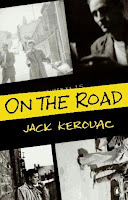
Posted by Daemios at 9:47 AM 0 comments
Monday, May 12, 2008
In some ways, you know, people that don't exist are much nicer than people that do.
Posted by Daemios at 11:14 PM 5 comments
Sunday, April 13, 2008
Bacillus coahuilensis : the genomical TexMex
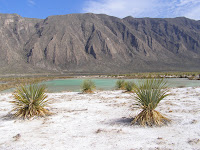
 After a long publication struggle, two articles from two close friends have finally been published: the description of novel species Bacillus coahuilensis by my former bacteriology teacher and former owner while doing my Social Service and actually the one to blame for my adscription to the lab I work in now, René Cerritos (a.k.a. Dr. Chapultepec) in the IJSEM Journal. The other is the publication of the complete genome sequence of the very same strain in PNAS by my former schoolmate, my former Represenant in the Universitary Council and beermate Luis Alcaraz (a.k.a. The Dude). Both are the product of a weird collaboration between the CINVESTAV and LANGEBIO in Iruapuato, the Texan universities of Rice and Houston and the institutes Biotechnology and Ecology in UNAM, where I'm at.
After a long publication struggle, two articles from two close friends have finally been published: the description of novel species Bacillus coahuilensis by my former bacteriology teacher and former owner while doing my Social Service and actually the one to blame for my adscription to the lab I work in now, René Cerritos (a.k.a. Dr. Chapultepec) in the IJSEM Journal. The other is the publication of the complete genome sequence of the very same strain in PNAS by my former schoolmate, my former Represenant in the Universitary Council and beermate Luis Alcaraz (a.k.a. The Dude). Both are the product of a weird collaboration between the CINVESTAV and LANGEBIO in Iruapuato, the Texan universities of Rice and Houston and the institutes Biotechnology and Ecology in UNAM, where I'm at.
In short:
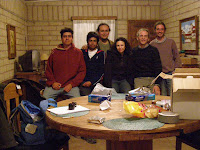 Cuatrociénegas Valley is in a 750 m basin above sea level in North Mexico, deep in the Chihuahuan Desert and formerly a coastal region during the Jurassic. It is characterized by the presence of many oligotrophic ponds in the middle of the desert supporting large bacterial communities, appearingly from a marine origin (as shown by Souza and Desnues), that have been studied by my labgroup leaded by Valeria Souza and Luis Eguiarte (the very same place where I'm conducting my Theses). Cerritos isolated many bacilli strains from one of the widest and shallowest pond (Churince's Laguna Grande) and found many moderately halophilic species (that tolerate slightly salty envirnoments). A novel aerobic strain (m44) belonged to a group of aquatic, moderatedly halophilic species (B .marisflavi, B. aquimaris, B. vietnamensis) , and could not grow on most sugar-contaning media (uncommon for the bacilli). The team in CINVESTAV sequenced the genome (leaded by Gaby Olmedo and Luis Herrera-Estrella) and Alcaraz anotated it. He also conducted most of the sequence analises, with some help of Siefert from Rice University, Putonti from the UofH and me, during our stay in Houston a year ago. The genome turned out to be the smallest genome within bacilli with 3.35 Mbp with many mobile elements.
Cuatrociénegas Valley is in a 750 m basin above sea level in North Mexico, deep in the Chihuahuan Desert and formerly a coastal region during the Jurassic. It is characterized by the presence of many oligotrophic ponds in the middle of the desert supporting large bacterial communities, appearingly from a marine origin (as shown by Souza and Desnues), that have been studied by my labgroup leaded by Valeria Souza and Luis Eguiarte (the very same place where I'm conducting my Theses). Cerritos isolated many bacilli strains from one of the widest and shallowest pond (Churince's Laguna Grande) and found many moderately halophilic species (that tolerate slightly salty envirnoments). A novel aerobic strain (m44) belonged to a group of aquatic, moderatedly halophilic species (B .marisflavi, B. aquimaris, B. vietnamensis) , and could not grow on most sugar-contaning media (uncommon for the bacilli). The team in CINVESTAV sequenced the genome (leaded by Gaby Olmedo and Luis Herrera-Estrella) and Alcaraz anotated it. He also conducted most of the sequence analises, with some help of Siefert from Rice University, Putonti from the UofH and me, during our stay in Houston a year ago. The genome turned out to be the smallest genome within bacilli with 3.35 Mbp with many mobile elements.
The most important feature of B. coahuilensis is that this is the second mexican microbial genome sequenced to date (the two bacteria genomes sequenced in Mexico are Rhizobium etli by the CCG and this), but whose sequence has been analized in the light of ecology and evolution (remember Dobzhansky's maxima?), that is, the adaptations of a formerly marine lineage to an oligotrophic lentic environment.That is, the sequence pointed towards an adaptation to growth within low-phosphorus environment: namely the presence of sulfoquinovose synthase (sdq1) that synthesises sulfolipids to replace membrane phospholipids (which constitute around 30% of the total phosphorus), never reported before outside chloroplasts and unicellular cyanobacteria. The CINVESTAV team looked into the membrane and corroborated its sulfolipid composition.
The genome also codes for a sensory bacteriorrhodopsin gene, reminiscent of its marine origin where they are very abundant (see work by Venter and Rusch). The expression analyses proved it to be constitutive and not -light dependent, suggesting it to be an adaptation to shallow-water irradiance exposure.
Analysing the enconded transmembrane importers is a good way to analyse what the organism is uptaking for the environment, that is, it's "feeding-habits". The family of Iron-Siderophore importers is overrerpresented in B. coahuilensis, a feature shared with other aquatic bacilli, suggesting that marine bacilli actively scavenge for iron. It also show a preference for the uptake of single aminoacids and not large polypeptides, with absolute requirement of 8 aa and partial of another 5, a feature shared by the aquatic, small-genome organism Minibacterium massiliensis.
This, taken together with the fact that it has the lowest number of genes involved in nitrogen cycle, together with the experimental evidence of being incapable of utilizing a wide variety of sugars, suggests that this organism is totally dependent of the rest of the community to live on, and has evolved from a primitive bacterial component of that community with specific adaptations for a novel environment.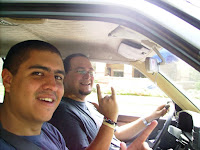 I'm very proud of the product of this collaboration and expect to continue this way. And also very happy because from the moment of this publication on, The Dude is able to obtain its PhD!!!
I'm very proud of the product of this collaboration and expect to continue this way. And also very happy because from the moment of this publication on, The Dude is able to obtain its PhD!!!
Posted by Daemios at 2:29 PM 2 comments
Labels: genomics, research post, ResearchInEnglish, UNAM
Monday, March 31, 2008
My Geek Pride is hurt: BLOSUM matrices
BLOSUM (BLOcks of Amino Acid SUbstitution Matrix) are the canonical substitution matrices used for scoring protein sequence alignments. In essence, it calculates the relative frequencies of all aminoacids in each position within an alignment and assigned a probability to the substitution of a particular residue. BLOSUM matrices built with closely related sequences are more stringent and have high numbers (BLOSUM80) indicating the percentage similarity allowed to include a sequence in the matrix (in the latter case, all proteins share at least 80% sequence identity).
BLOSUM matrices were developed in 1992 by Henikoff and Henikoff and since then have been extensively used in all analyses involving protein sequences...
and then, here comes he "AAARRGHHHH!!!"
Styczynski et al (2008) were killing their time looking at the evolution of the BLOCKS database and found the unthinkable.... an error in the source code for the algorithm that calculates de BLOSUM matrices!!!! that means... the results obtained with the available BLOSUM matrices differ significantly from the expected algorithm from Henikoff & Henikoff... merde!
Weirdest thing of all.. when corrected and tested back for the use of the matrices in database sequence search, it turned out that the "wrong" matrices performed much better in retrieving protein homologs than the "corrected" matrices.
Fortunately, it seems that though the difference is statistically significative, it is not big. That means, we haven't fucked it up so bad.
Epilogue to the blosum...
1) 16 years of extensive usage doesn't mean it is RIGHT.
2) how come that no one, ever, in 16 years, ever noticed this difference!!! THAT is what happens with dogma... when you take anything from granted
3) messing things up is not always THAT bad...
4) I didn't understand from the article if they proposed that the matrices were corrected even if they performed worse...
5) I would expect to see a huge ocean of erratas everywhere because "when using the revised blosum matrices... our results from the past ten years have completely changed!!"
Posted by Daemios at 4:55 PM 8 comments
Labels: research post, ResearchInEnglish
Tuesday, March 04, 2008
Bound to...
Diving into my ipod, I rediscovered what I think is one of the best breaking up songs ever. I'm not in that mood now, but I keep recognizing it. So, this post goes dedicated to all those girls that actually are brave enough to say 'I'm through'... I mean, there must be some!
"I've thought about it for a while
and I've thought about that many miles
but I think it's time that I've gone away
The feelings that you had for me
have gone away it's plain to see
and it looks to me
that you're pulling away
I'm gonna pick it up
I'm gonna pick it up today
I'm bound to pack it up
I'm bound to pack it up
and go away
I found it hard to say to you
that this is what I have to do
but there is no way that I'm gonna stay
there are someone many things
you need to know
and I wanna tell you before I go
but it's hard to think of just what to say
I'm gonna pick it up
I'm gonna pick it up today
I'm bound to pack it up
I'm bound to pack it up
and go away
I'm sorry to leave you all alone
you're sitting silent by the phone
but we've always known there would come a day
The bus is warm and softly lit
and a hundred people are ridin' it
I guess I'm just another running away
I'm gonna pick it up
I'm gonna pick it up today
I'm bound to pack it up
I'm bound to pack it up
and go away
Oh yeah, yeah"
The White Stripes, De Stijl...
Posted by Daemios at 10:03 AM 0 comments
Tuesday, January 22, 2008
Lotharingie... la breve

 "Uno cree que siempre ha sido así, pero no... no todo lo es todo. Aquello era vastísimo, y aunque no todos se asumían como francos, la dominancia carolingia era indiscutible. Siempre había sucedido así, los grandes imperios se resquebrajaban hasta minúsculos territorios. Así pasó con Cárthago, el Senatus Populusque Romanus de Trajan, el Khanato de Ögedei y el Califato Umyyad... así pasaría después con la dinastía Qing, la Totius Hispaniae de los Habsburgo, el Imperio Napoleónico, el Brazil de Braganza y la Soyuz Sovetskikh... así pasará con la Rossiyskaya transcontinental, la Francia de Ultramar, el paternalismo neocolonialista de la Norteamérica intervencionista y el mayor imperio en tiempo y extensión: el United Kingdom del imperio británico.
"Uno cree que siempre ha sido así, pero no... no todo lo es todo. Aquello era vastísimo, y aunque no todos se asumían como francos, la dominancia carolingia era indiscutible. Siempre había sucedido así, los grandes imperios se resquebrajaban hasta minúsculos territorios. Así pasó con Cárthago, el Senatus Populusque Romanus de Trajan, el Khanato de Ögedei y el Califato Umyyad... así pasaría después con la dinastía Qing, la Totius Hispaniae de los Habsburgo, el Imperio Napoleónico, el Brazil de Braganza y la Soyuz Sovetskikh... así pasará con la Rossiyskaya transcontinental, la Francia de Ultramar, el paternalismo neocolonialista de la Norteamérica intervencionista y el mayor imperio en tiempo y extensión: el United Kingdom del imperio británico.
El entonces imperio franco de Charlemagne había sido dividido por primera vez burdamente por Louis I (el primero de una veintena de luises hasta ahora) en imperios del Este y del Oeste. Lothair llevaba ya diez años defendiendo ferozmente su derecho legítimo sobre los territorios Francos. La última guerra civil (que entonces respondía a un pleito entre hermanos) culminó esa noche del 843 con el Tratado de Verodunum. Esa noche a la orilla del Meuse Lothair recordaba la figura de su abuelo, aún abatido al fondo del valle por el Juramento de Strazburg. Así nacía la Lotaringia, Lotharii regnum, bajo la tradicion divisionista hereditaria de los carolingios.
La Lotharingie sería recordada como el reino entre el Rhin y el Rhône, aunque más adecuado sería medirla entre la costa frisa del Mar del Norte a Roma. Así, con esa división entre el imperio Franco del Este y del Oeste, la Lotharingie iniciaría una larga disputa entre francos y alemanes que parece terminar apenas en la segunda mitad del siglo XX. Además resultaba ser el primer reino que no recibía su nombre del idioma que hablaban sus pobladores (Francs, Alemanii) puesto que comprendía un amalgama cultural y linguístico.
La duración del magno reino lotaringio fue ridículamente corto. Una del 855 presenciamos cómo el gran Lothair ha abdicado a la corona lotaringia para recluírse en la abadía de Prüm. Poco antes de tomar los votos, repartió el reino entre sus tres hijos. La Lotharingie queda reducida de la Frisia a la Suiza, bajo el reinado de Lothair II. Ésta divisón tampoco duraría mucho. Lothair moriría ese mismo año, Lothair II moriría en 869 sin herederos legítimos, lo que conduciría a la repartición territorial entre los hermanos de Lothair I y la consecuente desaparición del reino de Lotharingie con el Tratado de Meerssen... aunque en realidad el territorio norte se encontraba ya bajo el control vikingo danés."
La región es interesante...
más que nada, la aparición y desaparción de Las Cosas Importantísimas me recuerda también la historia de Plasmogenia... y no sin cierto temor me parece que la genómica le da un aire...
insisto, no todo lo es todo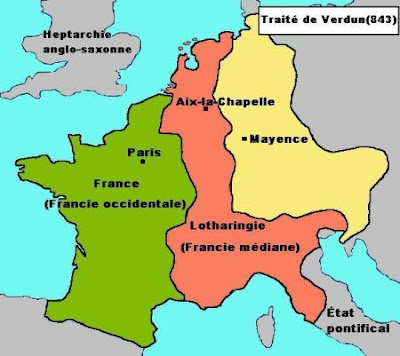
Posted by Daemios at 10:56 PM 3 comments
Thursday, January 10, 2008
La tektonik
One of the weirdest things I saw in France... a "new" dance style á lá techno-pop that reminds me a LOT of the early 90's... the rediscovery of Michael Jackson's Moonwalker maybe? if fashion has already made a complete turn and rap/dance/moonwalker is cool again... maybe we have a tiny hope of seeing a grunge retro-moment soon?
I find it good for gymnastics... and I think it's cool to see such self-assurance in teens!
Posted by Daemios at 4:16 PM 2 comments







